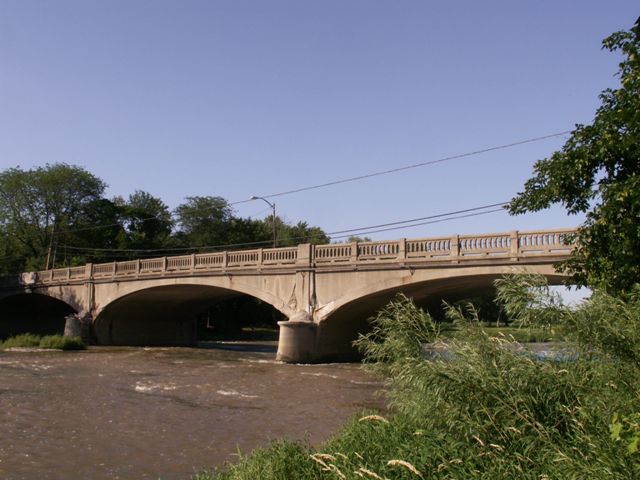We Recommend:
Bach Steel - Experts at historic truss bridge restoration.
Elmore Bridge

Primary Photographer(s): Nathan Holth and Rick McOmber
Bridge Documented: July 15, 2008
Elmore: Ottawa County, Ohio: United States
1926 By Builder/Contractor: Unknown and Engineer/Design: D. H. Overman and Ohio State Highway Department
Not Available or Not Applicable
76.0 Feet (23.2 Meters)
282.2 Feet (86 Meters)
30 Feet (9.14 Meters)
2 Main Span(s)
6201202

View Information About HSR Ratings
Bridge Documentation
This bridge no longer exists!
Bridge Status: Demolished and replaced.View Archived National Bridge Inventory Report - Has Additional Details and Evaluation
This bridge is a highly attractive, traditionally composed arch bridge. It retains original, unaltered railings. The bridge shows evidence of minor to moderate spalling. The time to preserve this bridge is now before structural and historic integrity is lost due to spalling. This is a preservation feasible and worthy structure in a county with relatively few historic bridges. The bridge is listed on the National Register of Historic Places.
Information and Findings From Ohio's Historic Bridge InventorySetting/Context The bridge carries a 2 lane street over a stream in Elmore. Physical Description The 3 span, 282'-long, reinforced-concrete arch bridge is finished with concrete balustrades. There are plain pilasters at the piers and the spandrel walls are plainly finished except for a series of widely spaced dentils that repeat the pattern of the balustrade posts. There is loss of fabric from spalling in the balustrades, spandrels, arch rings, and substructure. Integrity Loss of original fabric from spalling. Summary of Significance The 1926 arch bridge is NR-listed (1994). Although somewhat formulaic in its aesthetic details, it is one of the first significant arch bridges attributable to D. H. Overman, who would go on to become the state
highway department's arch expert and head design engineer. As such, the bridge marks the start of a distinguished career with the state highway department. Justification The bridge is one of over 210 extant examples built in the state starting in 1897. It was during the first decade of the 20th century that the bridge type gained currency, and in Ohio the golden age of reinforced concrete arches was the two decades following World War I when over 140 of the remaining examples were constructed by cities, counties, and the bridge division of the state highway department under the leadership of J.R. Burkey and D. H. Overman. Bridge Considered Historic By Survey: Yes |
![]()
Photo Galleries and Videos: Elmore Bridge
Bridge Photo-Documentation
Original / Full Size PhotosA collection of overview and detail photos. This gallery offers photos in the highest available resolution and file size in a touch-friendly popup viewer.
Alternatively, Browse Without Using Viewer
![]()
Bridge Photo-Documentation
Mobile Optimized PhotosA collection of overview and detail photos. This gallery features data-friendly, fast-loading photos in a touch-friendly popup viewer.
Alternatively, Browse Without Using Viewer
![]()
Maps and Links: Elmore Bridge
This historic bridge has been demolished. This map is shown for reference purposes only.
Coordinates (Latitude, Longitude):
Search For Additional Bridge Listings:
Bridgehunter.com: View listed bridges within 0.5 miles (0.8 kilometers) of this bridge.
Bridgehunter.com: View listed bridges within 10 miles (16 kilometers) of this bridge.
Additional Maps:
Google Streetview (If Available)
GeoHack (Additional Links and Coordinates)
Apple Maps (Via DuckDuckGo Search)
Apple Maps (Apple devices only)
Android: Open Location In Your Map or GPS App
Flickr Gallery (Find Nearby Photos)
Wikimedia Commons (Find Nearby Photos)
Directions Via Sygic For Android
Directions Via Sygic For iOS and Android Dolphin Browser
USGS National Map (United States Only)
Historical USGS Topo Maps (United States Only)
Historic Aerials (United States Only)
CalTopo Maps (United States Only)

